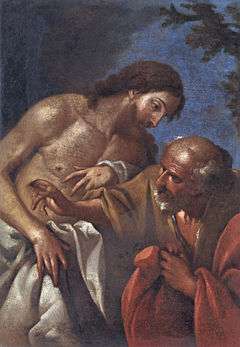John 20:29
John 20:29 is the twenty-ninth verse of the twentieth chapter of the Gospel of John in the New Testament. It records Jesus' reappearance to the disciples, including Thomas, eight days after his resurrection.
| John 20:29 | |
|---|---|
← 20:28 20:30 → | |
 Incredulity of Saint Thomas. Painting by Circle of Titian (–1576) | |
| Book | Gospel of John |
| Christian Bible part | New Testament |
Content
The original Koine Greek, according to the Textus Receptus, reads:[1]
- λέγει αὐτῷ ὁ Ἰησοῦς Ὅτι ἑώρακάς με Θωμᾷ πεπίστευκας μακάριοι οἱ μὴ ἰδόντες καὶ πιστεύσαντες
In the King James Version of the Bible it is translated as:
- Jesus saith unto him, Thomas, because thou hast seen me, thou hast believed: blessed are they that have not seen, and yet have believed.
The modern World English Bible translates the passage as:
- Jesus said to him, "Because you have seen me, you have believed. Blessed are those who have not seen, and have believed."
For a collection of other versions see BibleHub John 20:29
Analysis
Thomas's confession in John 20:28 has a significant weakness that it depends on sight, so Jesus needs to ' repetition of the words Thomas said a few days before (John 20:25) and the make an immediate correction by stating the 'greater blessedness of those who believe without seeing'.[2] With this statement, Jesus was not only reaching out to Thomas, but is reaching out to all future believers (cf. John 17:20-24) and embraces them all.[3] The followers of Jesus since the time of Jesus rely on 'secure evidence' (Scripture, the witness of the church through the ages, personal experiences in faith) without having actually seen Jesus.[2]
This verse is only beatitude, besides John 13:17, that is, using the formula of 'blessed' (Greek: makarios), in the Gospel of John,[4] and, like most beatitudes (cf. Matthew 5:3-12), contains 'a note of admonition'.[5]
Here is also 'the conclusion of the "literary partnership" shared by Mary of Magdalene and Thomas in John 20', where it traces the faith journey of both characters from misunderstanding and doubt to the acknowledgment of Jesus as the risen Lord in witnessing and confession. [6]
References
- Greek Text Analysis: John 20:29. Biblehub
- Guthrie 1994, p. 1064.
- Bruner, Frederick Dale (2012). The Gospel of John: A Commentary. Wm. B. Eerdmans Publishing. p. 1188. ISBN 9780802866356.
- Kieffer 2007, p. 998.
- Carson, D. A. (1991). The Gospel According to John. Pillar New Testament commentary (reprint ed.). Wm. B. Eerdmans Publishing. p. 659. ISBN 9780851117492.
- Köstenberger, Andreas J. (2004). John. Baker Exegetical Commentary on the New Testament. Volume 4 (illustrated ed.). Baker Academic. p. 580. ISBN 9780801026447.
Sources
- Guthrie, Donald (1994). "John". In Carson, D. A.; France, R. T.; Motyer, J. A.; Wenham, G. J. (eds.). New Bible Commentary: 21st Century Edition (4, illustrated, reprint, revised ed.). Inter-Varsity Press. pp. 1021–1065. ISBN 9780851106489.
- Kieffer, René (2007). "60. John". In Barton, John; Muddiman, John (eds.). The Oxford Bible Commentary (first (paperback) ed.). Oxford University Press. pp. 960–1000. ISBN 978-0199277186. Retrieved February 6, 2019.